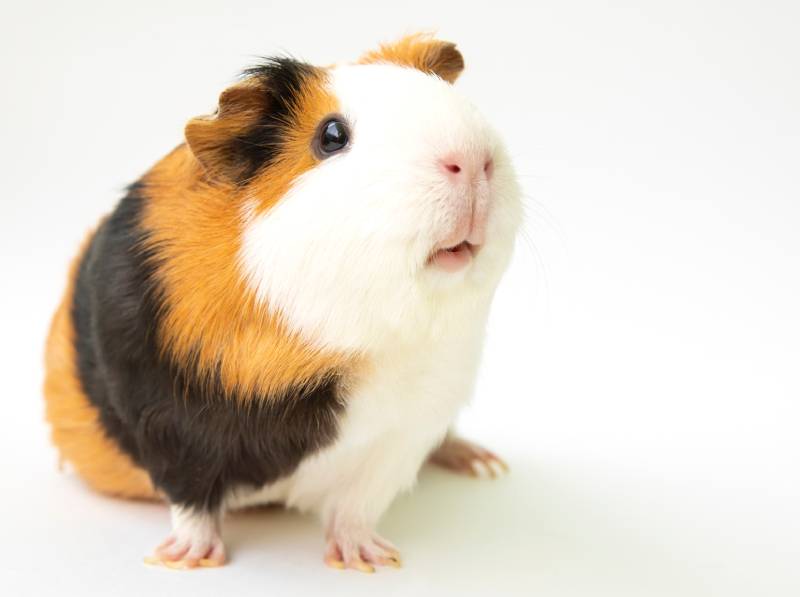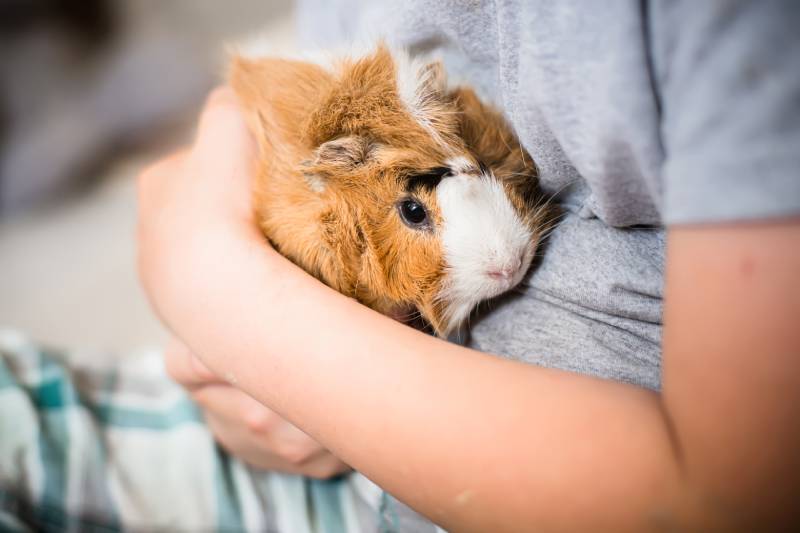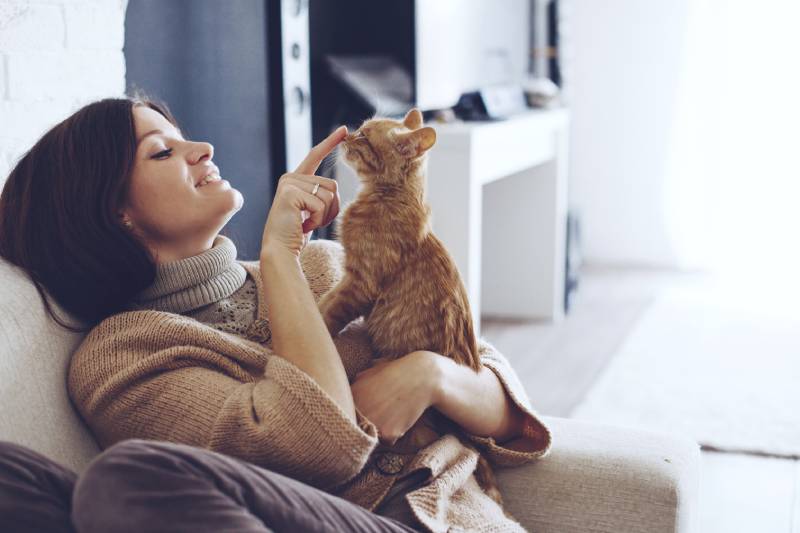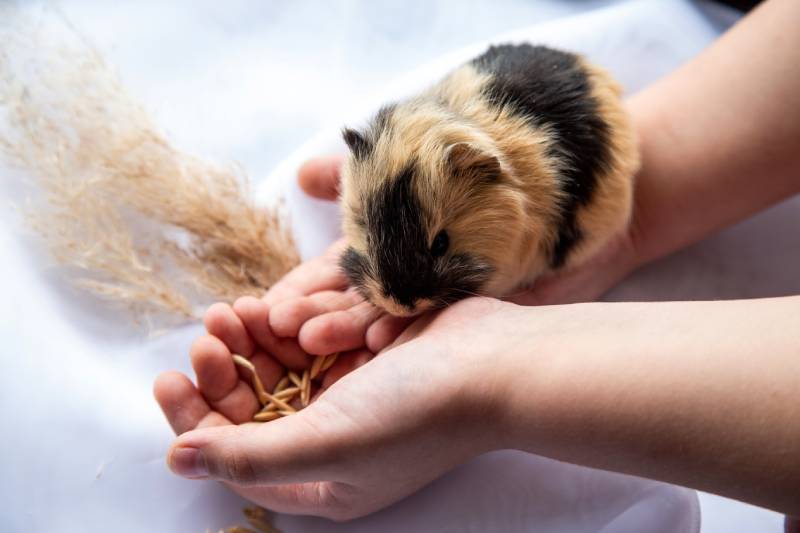
Anecdotally, there are a few households where cats and guinea pigs seem to coexist peacefully. However, you must remember that you are introducing a prey-predator relationship. Guinea pigs are prey animals, and they have a fight-flight-freeze response to almost any outcome. Guinea pigs run away, become frightened easily, and squeak loudly as a defense mechanism.
Since cats are predator animals, they will seek a guinea pig’s prey instincts as a game of cat and mouse. Cats will initiate play through stalking, chittering, and pouncing. In comparison, guinea pigs initiate play by chasing, grooming, rolling a ball, or burying toys as a hide-and-seek game.
Due to the natural instincts of these two animals, cats may become aggressive during playtime, while guinea pigs may become hurt due to the freeze-response and initial fear. In any case, guinea pigs and cats must be supervised during any interaction. However, cats and guinea pigs can get along in some circumstances, but again, you must always keep an eye on them.
The Likelihood of Cat and Guinea Pig Households
These two animals getting along depends on each animal’s temperament. However, to date there is no study which assesses the likelihood of these animals getting along and tolerating each other.
Cats are predators and instinctively view guinea pigs as prey, not friends. Even if your cat isn’t hunting, they can seriously injure a guinea pig by rough-housing them during play. A cat may also swipe at a guinea pig through a cage and cause an injury.
Guinea pigs are naturally neophobic, which means they fear new environments, objects, and experiences. This includes food items that they are unfamiliar with. A guinea pig that’s fearful may refuse to eat, which is incredibly problematic for the species. When confronted by a predator, guinea pigs may appear exceptionally stiff due to stress, a phenomenon known as tonic immobility.

Although there are examples of these two species coexisting on the internet, it is important to remember that such examples are exceptions to the norm and not something that is recommended or guaranteed if you ever attempt to adopt both guinea pigs and cats.
Guinea pigs and cats can live in the same house if they have their own space, and the possessions of each pet (including their toys) are never placed in a room where the other animal resides.
The Risks of Cat and Guinea Pig Households
Regardless of if your cat is friendly and wouldn’t allegedly hurt a fly or if they’re a natural-born hunter, you must always supervise the interaction between the cat and the guinea pig. Cats will always be a predator species, and their behavior towards your guinea pigs will always be unpredictable.
Some people recommend raising your guinea pigs with a kitten and having them grow up together. There is no proof of this reducing the risk of injury to either species, as kittens love to play and can seriously injure a guinea pig while playing with them, even if they don’t intend to actually hunt them as prey. Kittens practice their hunting skills during playing, often with toys, their littermates, or their caretakers. They may view a guinea pig as a playmate.
In any situation where your household inhabits predator-prey relationships, it’s best to keep your guinea pigs enclosed and only let them out when your cat is not around. Ensure each animal has their corner of the house and stays nearby during introductions. It is also important to use yourself as a defensive option for your guinea pig to keep them secure before attempting an introduction.

Introducing Cats and Guinea Pigs
There is no guarantee that an introduction between a cat and guinea pig will be successful. It is important to keep a very close eye on both species during any interaction attempts. Cats and guinea pigs should never be left in each other’s presence of company unsupervised.
Despite the predator-prey relationship, the goal or objective is to try at least to have each species become familiar with each other.
A peaceful relationship between cats and guinea pigs starts with and depends on how they’re introduced.
There are several guides on how to introduce the two species, with several differences in opinions and recommendations. The main steps of this process are as follows:
Please be mindful that during this period of separation, both animals should be offered adequate amounts of social interaction and appropriate care. Though your cat is a predator, it is important to not place them in “time out” – they do require your attention and socialization on a daily basis.

The steps above should be repeated on a daily basis until your cat seems completely aloof and oblivious to the guinea pig’s presence. At the same time, your guinea pig should be assessed for signs of stress, with special attention being given to their appetite changes (if any).
For a physical interaction without a cage, it’s best to ask for assistance from a relative or friend. This introduction involves holding the guinea pig securely and slowly allowing the cat out of their cage to assess their response. Cats are naturally inquisitive, so they would want to investigate your guinea pig, however, they should be discouraged from doing so if they do this with extreme enthusiasm or if they display stalking behavior. Ask your assistant to remove the cat from the room if you observe this behavior, or if your guinea pig doesn’t seem to appreciate the introduction of the cat.
Reward both animals with treats for positive behavior after an interaction with each other.

Can Your Cat and Guinea Pig Live Together if They Don’t Get Along?
Only you know your cats and guinea pigs’ temperament, what makes them upset, and how likely their personalities will mend. As mentioned, some cats are grumpy, aggressive, and focused on hunting. In most cases—but not all—cats will reject your guinea pigs and never get along. However, that doesn’t mean they won’t or cannot live together.
If your cat and guinea pigs have their own territory, they’ll never notice the nuisance or inconvenience the predator-prey species provides. So, don’t become discouraged if your cat hates your guinea pig or vice versa. It’s an instinct on both sides that their species cannot ignore.
Though you don’t have to stop trying to introduce the pairs, ensure you give both animals much love, care, and attention to avoid jealousy or resentment.
Tips for Keeping a Cat and Guinea Pig Household
You’ll need safety measures above all else when owning guinea pigs and cats. Although guinea pigs need much ventilation, and it’s best to have an open-roof enclosure, you may opt for a top with large breathable holes, but not big enough that your cat can get through. Ensure your guinea pig enclosure is not on a table where your cat can push them off. You can provide a different room strictly for guinea pigs, where it’s a no-cat zone.
To make the transition or new lifestyle run smoothly, here are some tips on how cats and guinea pigs can live together:

Final Words
While it’s widely believed that cats and guinea pigs will never get along, stranger things have happened. Many households have cats and guinea pigs who co-exist and, better yet, are friendly with each other. You must remember that no matter how friendly or aloof your cat may seem, their predator nature is a part of them. Likewise, guinea pigs will always be a prey species, and their behaviors are a big part of what activates the cat’s prey drive.
However, in some circumstances, it is possible for guinea pigs and cats to live together and accept—or at least tolerate—one another. It’s safe to say that cats and guinea pigs can get along and co-exist, but only on rare occasions.
Featured Image Credit: Susana Luzir, Shutterstock








